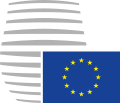
Back رئيس المجلس الأوروبي Arabic Presidente del Conseyu Européu AST Старшыня Еўрапейскага савета Byelorussian Председател на Европейския съвет Bulgarian ইউরোপীয় কাউন্সিলের সভাপতি Bengali/Bangla President del Consell Europeu Catalan Předseda Evropské rady Czech Formand for Det Europæiske Råd Danish Präsident des Europäischen Rates German Πρόεδρος του Ευρωπαϊκού Συμβουλίου Greek
| President of the European Council | |
|---|---|
 Emblem of European Council | |
 | |
| European Council | |
| Style | President[1] |
| Status | Presiding and chief administrative officer |
| Member of | European Council (non-voting) |
| Residence | Europa building |
| Seat | Brussels, Belgium |
| Appointer | European Council by qualified majority |
| Term length | 2.5 years, renewable once |
| Constituting instrument | Treaties of the European Union |
| Precursor | Chairman of the European Council |
| Formation | 1 December 2009 |
| First holder | Herman Van Rompuy |
| Website | consilium.europa.eu |
The president of the European Council is the person presiding over and driving forward the work of the European Council on the world stage.[2] This institution comprises the college of heads of state or government of EU member states as well as the president of the European Commission, and provides political direction to the European Union (EU).
From 1975 to 2009, the chair of the European Council was an unofficial position (often referred to as the president-in-office) held by the head of state or government of the member state holding the semiannually rotating presidency of the Council of the European Union at any given time. However, since the 2007 Treaty of Lisbon, article 15 of Treaty on European Union states that the European Council appoints a full-time President for a two-and-a-half-year term, with the possibility of renewal once. Appointments, as well as the removal of incumbents, require a double majority support in the European Council.
On 19 November 2009, the European Council agreed that its first President under the Lisbon Treaty would be Herman Van Rompuy (European People's Party), until then the Belgian Prime Minister. Van Rompuy took office when the Lisbon Treaty came into force on 1 December 2009 with a term stretching until 31 May 2012.[3] His term was later extended with a second period ending on 30 November 2014.
The second holder of the office was (until then) Polish prime minister Donald Tusk. He was originally elected to serve a term from 1 December 2014 to 31 May 2017,[4] and was subsequently re-elected on 9 March 2017 to a second term running from 1 June 2017 until 30 November 2019.[5]
On 2 July 2019 the European Council elected the until then Belgian prime minister Charles Michel as the successor to Donald Tusk as President of the European Council for the period from 1 December 2019 to 31 May 2022.[6] He was re-elected in March 2022 for a second term for period from 1 June 2022 to 30 November 2024.[7]
- ^ English Style Guide: A handbook for authors and translators in the European Commission (PDF) (8 ed.). European Commission. October 2019. p. 119. Retrieved 2 December 2019.
- ^ Treaty of Lisbon amending the Treaty on European Union and the Treaty establishing the European Community, Article 9 B
- ^ "European Council statement on the measures taken regarding the implementation of the Treaty of Lisbon" (PDF). Consilium.
- ^ "Italy's Mogherini and Poland's Tusk get top EU jobs". BBC News. 30 August 2014. Retrieved 31 March 2022.
- ^ Herszenhorn, David M. (9 March 2017). "EU leaders defy Warsaw to reappoint Donald Tusk". Politico. Retrieved 31 March 2022.
- ^ "Special meeting of the European Council (30 June, 1 and 2 July 2019) – Conclusions" (PDF).
- ^ "Charles Michel re-elected president of the European Council". www.consilium.europa.eu. Retrieved 19 October 2022.
© MMXXIII Rich X Search. We shall prevail. All rights reserved. Rich X Search
